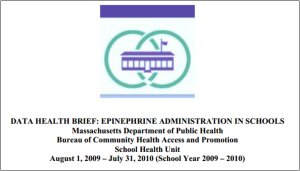The Management of Life Threatening Allergies in School: Lessons Learned from Massachusetts
Epinephrine Administration in Schools: Brief Summary
The 2010 statewide report added additional insight and addressed important questions : This section is a brief summary but for more detailed information see
DATA HEALTH BRIEF: EPINEPHRINE ADMINISTRATION IN SCHOOLS. Massachusetts Department of Public Health Bureau of Community Health Access and Promotion. School Health Unit.
There were 225 administrations of epinephrine for the treatment of allergic reactions in MA schools. The below is a brief summary.
Who Required Epinephrine?
25% of those requiring epinephrine had no previous allergy history reported to school.
9% of administrations in the school setting were to staff members.
What caused the reaction?
43% of the cases were believed to be caused by food; and
42% of the cases were recorded as an unknown cause.

What were the reported reactions?
Reported symptoms involved multiple organ systems such as the skin, gastrointestinal, respiratory, cardiovascular, or neurological. 60 % of the cases involved symptoms related to the skin such as hives, itchy skin or facial swelling. 79% of the cases, the symptoms reported involved the respiratory tract such as a tightness of the throat, wheezing, shortness of breathe, or difficulty swallowing. 34% of the cases had gastrointestinal symptoms such as nausea or “oral tingling” were reported.
11% of the cases had neurologic symptoms including light headedness and feeling of anxiety. 4% of the cases had cardiovascular symptom including tachycardia.
Where in school did symptoms begin?
45% of the cases had symptoms develop in the classroom; other locations included the cafeteria (14%), health office (9%), playground/outside/recess (7%) and various locations both inside and outside the school building.
Who administered the epinephrine?
92% of epinephrine administrations were performed by registered nurses. In 5% of cases, epinephrine was administered by other types of personnel such as a teacher, coach, administrator and parent. All unlicensed personnel had been appropriately trained by the school nurse in the administration of epinephrine. 3% of cases self-administered epinephrine (age 10-18).
How long did it take to administer epinephrine?
Epinephrine was administered in 10 minutes or less 66% of the time (Range: 0 – 150 minutes), after the development of symptoms.
What was the disposition after the administration of epinephrine?
Five students were not transported to a medical facility via the Emergency Medical System. In all cases, the decision not to transport was made by a parent.
All excerpts taken from the Management of Life Threatening Allergies in School: The Massachusetts Experience.
Written by: Michael Pistiner MD, MMSc and
Anne H. Sheetz RN, MPH, NEA-BC.
This piece was originally published in the American Academy of Pediatrics, Council on School Health, Spring/Summer 2009 Newsletter.
We thank the AAP for granting permission to post and to update mandated reporting data within this article.
